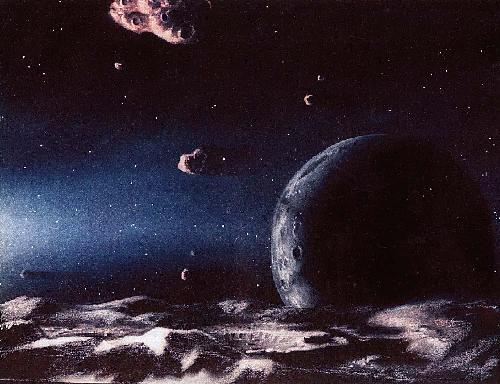 |
Kuiper Belt |
|---|
| WHY "KUIPER" BELT? |
|---|
The Kuiper Belt Gerard Kuiper (it is pronounced like "Viper"[thanks, Maaike] although a lot of people try it as "Coyper", for reasons which remain unclear) was an astronomer interested in the solar system at a time when this interest was even less fashionable than it is today. He wrote a paper including a mention of objects beyond Pluto (note: not Neptune) in 1951 and the Kuiper Belt is so-called because of this paper. The reference is G. P. Kuiper 1951, in Astrophysics: A Topical Symposium, ed. J. A. Hynek, New York: McGraw-Hill.
The problem with Kuiper Belt is that Kuiper did not, by any objective reading, really predict the object to which his name is given. Kuiper's paper refers to a primordial set of bodies that he supposed were scattered out to the Oort Cloud by massive Pluto, so that if taken at face value his paper predicts there should be nothing where we now see Kuiper Belt Objects. (He wrote "..We must therefore assume that the planet Pluto is responsible for the dispersal of the comets (to the Oort cloud)".) Kuiper in fact anti-predicted what we now call the Kuiper Belt. We now know that Pluto is tiny and has too little mass to eject objects to the Oort Cloud.
Other ideas in Kuiper's paper are stranger still, but rarely mentioned. He thought that Pluto was an escaped moon of Neptune. He thought that comets were scattered by Pluto into the Oort cloud where they were stored.
The Edgeworth Belt Kenneth Edgeworth wrote papers about objects beyond Pluto in 1943 and 1949. His work was not cited by Kuiper, presumably because he had overlooked it (although one sometimes hears dark rumors that Kuiper chose to ignore Edgeworth's prior work). See K. E. Edgeworth 1943, J.B.A.A. 53, 186.
Edgeworth's papers were, in some ways, closer to the belt of objects observed beyond Neptune, although the relevant parts amount to barely a paragraph. At least he didn't anti-predict the belt. His work, though, is not quantitative and he makes no important predictions about these objects so that some say it is just a conjecture, not really a theory based on understanding. In fact, his paper contains remarks that don't even translate well across the intervening 60 years. What exactly are those "clusters" he's writing about? If he were alive, I'd have to ask him what he was trying to say.
The Leonard Belt Worse, for both Kuiper and Edgeworth, is the recent finding that Fred Leonard of UCLA mentioned in print the possibility of trans-Plutonian objects as early as 1930 (the reference is suitably obscure: Leaflet Astron. Soc. Pacific No. 30, pp. 121-124).
The Name Game Presumably, the intent should be to do the right thing by attributing credit where it's due. Unfortunately, it's not clear to me where, if anywhere, proper credit is due. Just hand-waving on the possibility that there might be something "beyond Pluto" is not sufficient. Some of the above seem a bit like the predictions of Nostradamus: read into them what you will. If anything, I would say that J. Fernandez most nearly deserves the credit for predicting the Kuiper Belt based on clear statements and physical reasoning. His 1980 paper (Monthly Notices of the Royal Astronomical Society, 192, 481-491) is worth a careful read.
The Name Game is not new in science: we associate Darwin with evolution much more than we associate it with Alfred Wallace (although Wallace, who worked independently of Darwin, was ready to go public with the idea before him). There's even a name for it: Stigler's Law asserts that "No scientific discovery is named after its original discoverer". This is obviously too strong a statement, but it captures a truthful essence (and has lead to the inevitable claim that Stigler's Law was in fact discovered by someone else, long before Stigler wrote about it. So there).
The Logical Alternative Call them "trans-Neptunian" objects.